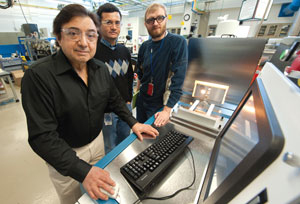Bhushan Sopori Uses Light to Boost Solar Cell Efficiency
Bhushan Sopori has led the development of an optical furnace that not only saves energy baking solar cells but improves their ultimate photovoltaic efficiency in turning photons into electricity.
National Renewable Energy Laboratory (NREL) principal engineer Sopori has developed the Optical Cavity Oven (OCO) which uses light instead of heat to bake photovoltaic cells. Because the light energy goes almost entirely to heating the silicon wafers instead of the surrounding furnace, the OCO uses only half the energy of conventional ovens.
Using a configuration of lamps and highly reflective and heat-resistant ceramic chamber walls, the OCO directs heat evenly onto the silicon wafer. It is so efficient that when the wafer is heated to the requisite 1,000 degrees Celsius the furnace itself is only warmer by a few degrees. Because light is far easier to direct than heat energy, the OCO has even been tweaked to direct a bit more energy to the edges of the wafers which lose more heat through dissipation. Its relative efficiency has been analogized to the difference between heating food in a microwave oven as opposed to a convection oven.
Saving energy is only one of the OCO’s advantages over conventional furnaces. The other is that its use results in photovoltaic cells that are about 4% more efficient at converting sunlight into electricity, raising the conversion efficiency from about 16% to around 20%. That’s because the process of slowly heating the wafers with light pushes out efficiency-harming impurities like iron but not necessary ones like boron.
Another advantage of the OCO is that it costs only about a quarter as much to build as conventional ovens. And they work on both multicrystalline and monocrystalline silicon cells.
NREL is working with AOS Solar of Torrance, California to develop the first commercial OCO capable of processing 2,000 wafers per hour. A prototype oven will take about a year to build after AOS raises the needed funds.
Sopori’s team hasn’t yet realized the full four percent improvement in the efficiency of the finished photovoltaic cell because the team is still in the process of modifying some of the steps in conventional solar cell manufacturing to take full advantage of the OCO.
In June 2011 Steve Chu recognized Sopori’s team with an R&D 100 Award for the Optical Cavity Oven. Sopori has spent about two decades developing the OCO.

Bhushan Sopori led an NREL team in developing a highly efficient Optical Cavity Oven for producing solar cells.

